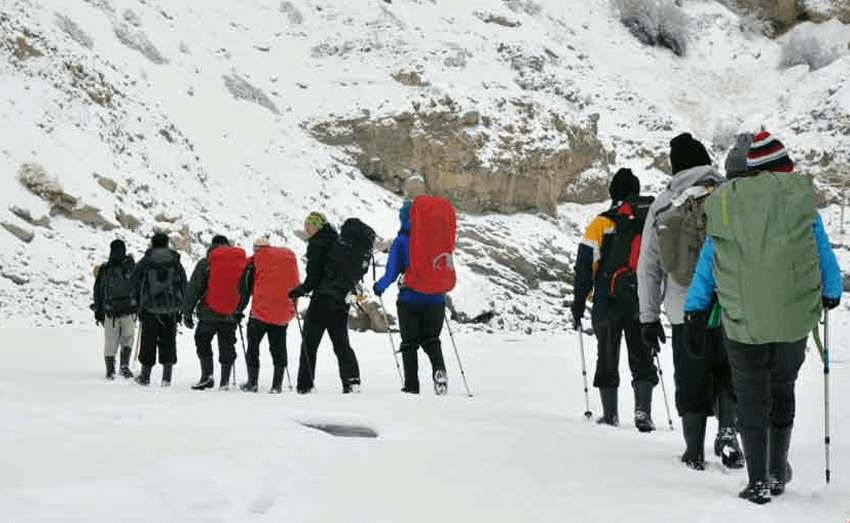On Hold : Chadar Tibb Gyalpo Trek: A 9-Day
Day 01: Arrive in Leh and Explore the Town
As you fly over the snow-capped mountains of Ladakh, you'll understand why it's impossible to reach this region by road in the winter months. Landing at the Leh airport, one of the highest in the world, you'll be greeted with crisp, fresh air and a significant drop in temperature.
Although the town is just awakening from its winter slumber, you can take a stroll through the Leh market to find a few shops and eateries open for last-minute trek shopping. However, the chill in the air will only give you a preview of the freezing temperatures you'll face during your winter trek. You'll spend the night in a cozy guest house.
Day 02: Drive to Tilad Do via Chilling
Start your morning by witnessing the sunrise from the Shanti Stupa, offering a panoramic view of Leh and its surroundings, including Stok Kangri peak. But today's agenda involves a thrilling long-drive to Chilling, offering picturesque views along the Indus to the village of Nimu, where Zanskar converges into Indus.
After stopping at this confluence point to take in the view, the road begins to descend right into the river valley. Brace yourself for some heart-stopping moments as the vehicle navigates steep hairpin bends over snow-covered roads. The road goes past Chilling to Tilad Do, where you'll cross the frozen Zanskar to reach your campsite.
As you take your first steps on the Chadar, it takes a while to get a hang of walking on the ice sheet. After reaching the campsite, you can climb nearby mountains and get a good look at the frozen river. As the sun sets, the temperature drops, and the warm sleeping bags in your tent become quite inviting.
Day 03: Tilad Do to Gyalpokyalzos
The biggest challenge of this day and the remaining days is to get out of the warm sleeping bags and go out into the freezing outdoors. However, the steaming cups of tea being served provide ample motivation.
Today, you'll embark on a long walking session, about 12 km, on the Chadar. The trek leaders from LIFE on the PLANET LADAKH give a briefing about the day and give tips on how to walk on the Chadar. Depending on the weather, the Chadar can assume various forms, such as a slippery ice surface or a dusting of snow over it, providing a good grip.
The ice can be thick or thin, and it's best to keep closely following the guide. Locals have a sixth sense as to where to step on the Chadar. At times, it might be necessary to wade through ankle-deep water or climb the cliffs at the side of the river.
As you walk on the Chadar, you'll get used to it, and it will feel like a cross between gliding and skating. Midway to Gyalpo, the porter-cum-cooks will prepare hot bowlfuls of soupy noodles for lunch. It's important to keep up a decent level of fluid intake to help you adapt to the conditions faster.
After passing Shingra Koma, you'll reach the campsite for the day at Gyalpo, where the tents have already been pitched by the porters. The Gyalpo campsite is at a bend in the river, surrounded by high peaks and walls of rock-faces that almost look man-made. Soak in the views, have an early dinner, and call it a day.
Day 04. Gyalpo kyalzos to Tibb Cave
Wake up early to enjoy a cup of tea before breakfast at 8 am, followed by a quick-march at 8:30 am. Be sure to have a good breakfast, as today is the longest walk of the trek at almost 14 km. But don't worry, the walking will keep you incredibly warm.
Today's trek takes you through the deep ravines of the Zanskar, with sublime mountain walls on either side of the river that keep the sunlight away for most of the day. You'll see numerous caves, big and small, as well as frozen waterfalls, some of which are higher than others.
Legend has it that centuries ago, local villagers faced a water shortage and went to Tibet to plead for water. They were given a box that they were to open once they reached the village, but curiosity got the better of them, and two fishes jumped out of the box, creating two huge waterfalls. One of those waterfalls, miraculously, is not iced-up even in such freezing cold.
At Tibb, you'll find a big cave that serves as the dwelling for all the porters. They welcome you warmly and invite you to share a cup of butter-tea with them, the highlight of the day.
Day 05. Tibb Cave to Naerak
Today is the most spectacular day of the trek. Walking on the river, you'll cross deep gorges and reach a point where Juniper trees are covered with prayer flags. The porters will give you a twig of this tree tied with a piece of prayer flag as a badge of good-luck and good-health.
A few steps away stands the mother-of-all frozen waterfalls, a huge instance of suspended animation several feet tall and equally wide. You can see dozens of colors in this enormous ice structure as sunlight plays off its surface. Right next to the waterfall is a bridge across the river that is part of the summer-time road from Zanskar to Leh.
The Naerak village lies several feet above the river, and a vigorous hour-long trek can take you there if you want to see the life of a Zanskari. The camp is set up close to the river, so you can enjoy the serene sound of the flowing water as you relax and take in the breathtaking surroundings.
Day 06. Return Journey to Tibb
Today, we begin the return journey to Tibb cave, but don't expect to be retracing the exact same path back to Chilling.
The Zanskar River is constantly changing due to temperature fluctuations, and the Chadar takes on a completely new form.
You'll see locals wearing traditional woolen Gonchas, including monks hiking from Lingshed Monastery to Leh, and young students with their parents returning to school after winter vacation.
Observe the locals as they expertly navigate the Chadar, seemingly unfazed by the sub-zero temperature and biting cold winds.
Day 07. Tibb to Gyalpo
Today's trek takes us from Tibb to Gyalpo, passing by castle-like walls of mountains rising on both sides of the river.
Keep an eye out for footprints belonging to foxes, ibex, or even snow leopards, which are known to inhabit the area.
While it's rare to spot a snow leopard, it's highly likely that they're watching you from afar.
Day 08. Gyalpo to Tilad Do and Departure
On this last day of trekking on the Chadar, take in the beauty of the frozen river before bidding farewell to Zanskar and the friendly Zanskari people.
Once you reach Tilad Do, our team and porters will take care of you before driving back to Leh, where you'll spend the night in a cozy guesthouse.
Day 09. Departure from Leh
Depart from Leh, reflecting on your incredible adventure trekking on the frozen Zanskar River and the unique culture and traditions of the Zanskari people.



